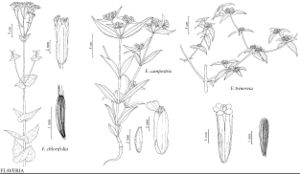| Taxon | Illustrator ⠉ | |
|---|---|---|
 | Flaveria chlorifolia Flaveria campestris Flaveria trinervia | Barbara Alongi Barbara Alongi Barbara Alongi |
Annuals, perennials, or subshrubs, to 200+ cm [trees to 400 cm] (usually ± succulent, herbage usually glaucous). Stems (often purplish) erect or decumbent, branched distally or ± throughout. Leaves cauline; opposite (decussate); petiolate or sessile (weakly connate to connate-perfoliate); blades (often 3-nerved) oblong-ovate to lanceolate or linear, margins entire, serrate, or spinulose-serrate, faces glabrous or short-pubescent. Heads radiate or discoid, usually in tight or loose aggregations in (often flat-topped) ± corymbiform arrays or glomerules. Involucres oblong, urceolate, cylindric, or turbinate, 0.5–2 mm diam. Phyllaries persistent, 2–6 (–9) in ± 1 series (linear, concave, or boatshaped, subequal). Receptacles convex, epaleate (“receptacles” of glomerules sometimes setose). Ray-florets 0–1 (–2), pistillate, fertile; corollas yellow or whitish (laminae inconspicuous). Disc-florets 1–15, bisexual, fertile; corollas yellow, tubes shorter than to about equaling funnelform to campanulate throats, lobes 5, ± deltate. Cypselae (black) weakly compressed, narrowly oblanceolate or linear-oblong (usually 10-nerved, glabrous); pappi usually 0, sometimes persistent, of 2–4 hyaline scales, or coroniform (of connate scales). x = 18.
Distribution
United States, Mexico, West Indies (Greater Antilles), Central America, South America, Asia (India), Africa, Australia
Discussion
Species 21 (8 in the flora).
Members of Flaveria are frequently found in alkaline, saline, and gypseous soils, often in disturbed and moist areas. Heads of Flaveria may be either radiate or discoid; when both are present in the same capitulescence, the discoid heads tend to be central and the radiate heads peripheral. Many species of Flaveria have persistent sheathing leaf bases that ring the stems after the leaves have fallen.
Flaveria is notable because certain species exhibit C3 photosynthesis, some C3–C4 (intermediate) photosynthesis, and others (F. brownii, F. bidentis, F. campestris, and F. trinervia in the United States) classic C4 photosynthesis.
Selected References
Lower Taxa
Key
| 1 | Pappi usually of 2–4 scales or coroniform, rarely 0 | > 2 |
| 1 | Pappi 0 | > 3 |
| 2 | Leaf blades to 10–40 mm wide, bases connate-perfoliate; New Mexico, Texas | Flaveria chlorifolia |
| 2 | Leaf blades 2–7 mm wide, bases weakly connate; Arizona | Flaveria mcdougallii |
| 3 | Heads in tight, axillary glomerules ("receptacles" of glomerules setose) | Flaveria trinervia |
| 3 | Heads usually in corymbiform, paniculiform, or spiciform arrays, seldom in tight, axillary glomerules ("receptacles" of glomerules not setose). | > 4 |
| 4 | Annuals | > 5 |
| 4 | Perennials (annuals) | > 6 |
| 5 | Heads in scorpioid cymiform arrays; ray laminae to 1 mm; Alabama, Florida, Georgia | Flaveria bidentis |
| 5 | Heads in corymbiform arrays; ray laminae 1.5–2.5 mm; sc, sw United States | Flaveria campestris |
| 6 | Calyculus bractlets surpassing involucres (sw coast, Florida) | Flaveria floridana |
| 6 | Calyculus bractlets shorter than involucres | > 7 |
| 7 | Ray laminae oblong-elliptic, 2 mm; disc florets (5–)7–10; Texas | Flaveria brownii |
| 7 | Ray laminae oval to obovate-spatulate, 2–3 mm; disc florets (2–)5–7(–8); Florida | Flaveria linearis |